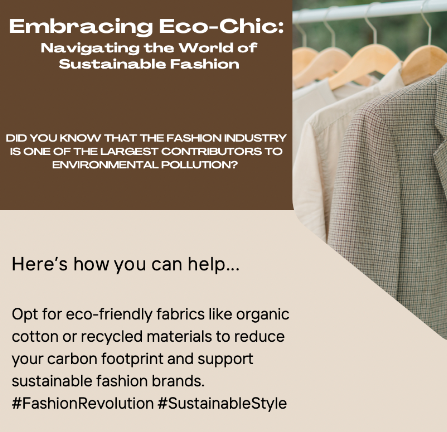By: Daneev Imbert

Sustainable fashion has emerged as a change agent in an industry that is often wasteful and fast-paced. The sustainable fashion movement is altering the way we view fashion, from eco-friendly fabrics and ethical production. Some examples of eco-friendly fabrics are organic cotton, hemp, bamboo, Tencel, and recycled fabrics like polyester made from recycled plastic bottles. Some examples of ethical production methods include ensuring fair wages, reasonable working hours, and adherence to international labor standards. Let's look at its significance, key principles, and actionable steps toward creating a wardrobe that not only looks good but also feels good for the environment.
Why Sustainable Fashion Matter
The fashion industry is well known for its environmental impact. Conventional fashion practices significantly contribute to environmental degradation, covering everything from water pollution to excess waste. Sustainable fashion can reduce these effects by using eco-friendly materials, responsible manufacturing methods, and waste reduction strategies.
Fast fashion often relies on exploitative labor practices, with workers facing poor working conditions and low wages. Sustainable fashion prioritizes ethical production, including fair wages, safe workplaces, and the overall well-being of those involved in the supply chain.
Principles of Sustainable Fashion
Choose clothing made from sustainable materials, such as organic cotton, hemp, Tencel, or recycled fabrics. These materials have fewer environmental consequences than traditional ones. Always check the label for the materials, and if you can't find it, remember that Google is your friend!
Embrace slow fashion by investing in timeless, high-quality pieces that resist trends and last longer. This strategy decreases the demand for fast, disposable fashion. I believe that buying one high-quality item is preferable to purchasing five low-quality items.
Support brands that promote recycling, upcycling, and circular production models to foster a sustainable fashion mindset. This reduces the fashion industry's contribution to landfills while encouraging a more sustainable clothing lifecycle.
Practical Tips for Embracing Sustainable Fashion
● Visit thrift stores and secondhand stores to find one-of-a-kind and gently used fashion items. Thrifting not only encourages sustainable consumption, but it also reduces the demand for new production. Later in this blog, I will give you my top thrift recommendations in the DMV (DC, Maryland, Virginia)
● Prioritize timeless, versatile pieces that can be mixed and matched to create multiple looks. Quality over quantity ensures that each garment lasts longer, reducing the need for frequent replacement. Remember everybody needs a few statement pieces in their wardrobe.
● Spend time researching and supporting brands that are committed to sustainability and ethical practices. Many emerging and established brands are implementing eco-friendly initiatives, making it easier for customers to make conscious decisions. This could be through recyclable materials, or
natural dyes.
● Get creative and repurpose old items with do-it-yourself (DIY) projects andupcycling. Clothing that has been redefined or repurposed is less likely to end up in landfill. Try going on Youtube and looking up upcycling videos or DIYs.
Thrifting Across the DMV

○ CUA Cardinal Closet (Brookland, DC): An easily accessible thrift store on campus. The Cardinal Closet is CUA’s first on Campus thrift store. It is located in Gibbons Hall. The Cardinal Closet serves as a sustainable fashion option for all members of CUA. It is based on donations from other students, staff, and departments.
○ Meeps (Adams Morgan, DC): A vintage lover's dream, Meeps in Adams Morgan is renowned for its carefully curated selection of retro clothing and accessories. Whether you're into 80s denim or 60s dresses, Meeps has something for every vintage enthusiast.
○ Buffalo Exchange (Foggy Bottom, DC): Located in the heart of DC, Buffalo Exchange offers a unique combination of thrift and resale. Bring in your gently used items and trade them for store credit or cash, making it a sustainable and wallet-friendly option.
○ Savvy Consignment (Annapolis, MD): This consignment store is a haven for those seeking high-quality, gently used clothing, accessories, and home decor. With a carefully curated selection, Savvy Consignment is perfect for fashion-forward thrifters looking for unique pieces.
○ Value Village (Silver Spring, MD): Nestled in Silver Spring, Value Village is a thrift store chain offering a vast array of pre-loved items. From clothing to furniture, you'll find affordable treasures here. Keep an eye out for their frequent sales and discounts.
○ Unique Thrift Store (Falls Church, VA): As the name suggests, Unique Thrift Store in Falls Church lives up to its reputation. This spot is perfect for those seeking a bit of everything, from clothing to home goods, all at budget-friendly prices.
○ Goodwill Outlet (Alexandria, VA): For a unique thrifting experience, head to the Goodwill Outlet in Alexandria. Items are sold by the pound, providing an affordable way to score fantastic deals. Be prepared to dig and discover hidden gems in this treasure trove.
References
● Fletcher, Kate. Sustainable Fashion and Textiles: Design Journeys. Routledge, 2014.
● Brown, Sandy. Sustainable Fashion: Past, Present and Future. Bloomsbury Publishing, 2019.
● Niinimäki, Kirsi. Sustainable Fashion in a Circular Economy. Routledge, 2018.
● Bhardwaj, Vinay, and Anupama Pasricha. Handbook of Research on Global Fashion Management and Merchandising. IGI Global, 2020.
● McDonough, William, and Michael Braungart. Cradle to Cradle: Remaking the Way We Make Things. North Point Press, 2002.
